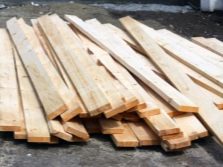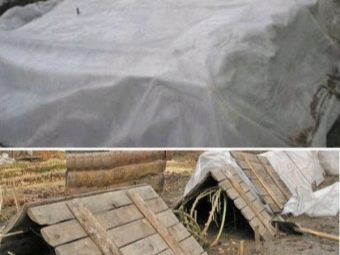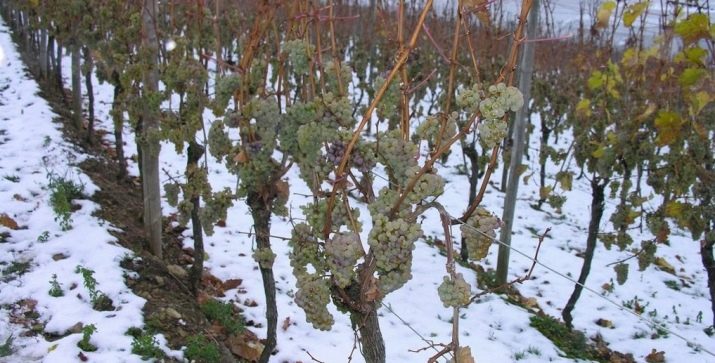How to cover the grapes for the winter?

Fruits of grapes from time immemorial enjoyed reverence and demand. Since ancient times and at the moment berries are used to prepare wines, juices and various dishes. Today, gardeners have the opportunity to choose among a huge variety of varieties that differ in taste, cultivation features and other characteristics. In this case, not only care is important, but also the protection of grapes in the cold season.
Special features
Despite the fact that Russia is a northern country, experienced agronomists manage to grow grapes in various regions, regardless of climatic conditions. Plant care includes certain requirements. To protect the grapes from frost, it is necessary to cover it for the winter and properly take care of the plant at this time of year. There are many different techniques that are used to achieve certain results.
Ways to harbor grapes are aimed at preserving the root system and the vine from frost. Despite the fact that in the harsh regions of the country grow resistant species of grapes that are not afraid of low temperatures and other weather vagaries, plants need additional protection. Special care requires dining varieties that can die with improper care.
Training
Summer residents and gardeners with the experience who are engaged in cultivation of grapes for many years, have available the huge range of various adaptations and types of covering material. At this stage it is necessary to stock up on the following:
- straw;
- boards;
- woody shields;
- grid;
- racks;
- mats;
- durable film;
- textile material (burlap);
- spunbond.
The choice of type of protection and covering material depends on the following factors:
- maximum temperature index of frost;
- features of the local climate;
- the length of the period from autumn to spring frosts;
- snow cover thickness;
- precipitation intensity;
- cultivation region.
Before you begin work, you must properly prepare the plant. If you do not comply with agricultural technology, the grapes will spoil due to fungal diseases or mold. Also, the culture is often subjected to attacks from rodents.
To shrubs survived the cold season, the following work should be done.
- During the dry autumn it is necessary to water the plant carefully and regularly.
- Phosphate-potash and potash supplements are added to the soil in September.
- Undispersed vine removal is carried out only after the foliage has subsided. Young branches are green. In winter, such a vine still freezes, only thick shoots remain.
- It is necessary to organize an additional load, leaving no more than three kidneys above the normal amount.
- Shrubs are treated with a solution with the addition of iron or copper sulphate (3%). Various commercial preparations are also used to protect against harmful insects.
- Next, you should do the aboveground part of the plant, carefully removing the branches from the wire or any other structure. Shoots bind, forming loose bunches.
- If you use a technique that involves the use of trenches, they must be prepared together with a covering material.
Material disinfection
If it is planned to use mats, burlap or spunbond as cover, they must be properly prepared. The material must be cleaned, dried and treated with antifungal composition. Before use it is stored in a dry and dark place.
A solution based on copper sulphate (5-7%) is used for spraying flooring of various materials: wood, mat, and roofing material. You can also use ready-made formulations to protect against pests and the development of bacteria. Everything neatly folds under a canopy before use.
Before covering the plant, the materials used are carefully inspected. Rotten items should be destroyed.
In the autumn, there is a procurement of additional covering products: straw, coniferous spruce branches, foliage and other things. Dead leaves should be thoroughly dried and treated with antifungal formulations.
To protect the shrub from rodents, special insecticide herbs are used. Ideal fit various fragrant plants, including marigolds and marigolds. Together with herbs, dust and other poisonous impurities are used.
How to cover?
Experts note that there are several methods for protecting the plant during frost:
- parachute dropping;
- semi-cover;
- complete shelter.
Each of the above methods has individual features and is used depending on the task. The plant necessarily needs shelter in the first years of life, irrespective of the region of cultivation. Saplings, whose age ranges from 1 to 2 years, are particularly sensitive and susceptible. Also, hybrid, European varieties and those types of grapes that are unstable to temperature changes need mandatory protection.
In the south of the country, the process of sheltering plants begins in the middle of the last autumn month. Initially, gardeners conduct the process of protecting the root system. Roots begin to freeze out gradually at temperatures from 5 to 7 degrees Celsius below zero. Once the temperature is set between 0 and 4 ° C, gardeners form a hill out of the ground around the trunk.
To perform the work using the soil, taken between the rows of plantations. Protection with the use of soil is carried out so that the head of the bush and the lower element of the trunk are completely covered. The optimum embankment height varies from 10 to 25 centimeters with a diameter of 30 centimeters. Dimensions are selected depending on the age of the plant.
Horticulture professionals say that the vine of frost-resistant plant species tolerates frost problems up to 15 degrees Celsius without any problems. In this case, if the temperature does not fall below the above figure, there is no need to protect the branches. It is enough only to protect the root system.
Vine carefully and carefully removed from the supports and laid on the ground. To prevent the branches from touching the ground, use boards, durable fabric, plywood. They can also be placed on the bottom wire of the support. If there is a decrease in temperature, it is necessary to cover the entire plant as soon as possible.
In some southern regions of Russia and in the middle lane, half-cover is widely used. Judging by the name, it is easy to guess that this technique provides for partial protection of the bush from frost. In this case, only the part of the plant that is closer to the ground is covered.
Due to the fact that the cold accumulates mainly in the area of the upper layer of soil, the grapes close the sleeves, the base of the lower large shoots and the head. If necessary, the remaining parts of the shrub covered with various materials. Use textiles, protective straw shelters and more. The minimum layer thickness is 4 centimeters. Work is carried out as carefully as possible so as not to damage the branches and buds.
Other options are possible. On both sides of the plant they dig up small trenches. Vines of young plants, which have not yet had time to mature, are placed in them and covered with a layer of soil no more than 15 centimeters thick. The areas between the rows, from where the earth was taken to shelter the grapes, must be carefully dug up, otherwise moisture will begin to accumulate in this area.
If the grape has a small growth, it can be protected with insulation without removing it from the supports. This method takes a minimum of time and effort.
Ordinary plastic bottles are used as reliable and budgetary protection of young plants. The most commonly used transparent packaging volume from 3 to 5 liters. Suffice it to cut the bottom and sink the lower part of the soil. The bottle is covered with earth, and the cork is removed.
The third method is used in the northern regions with the most severe climate, where in the winter period, the indicators of outdoor thermometers fall below 20 degrees Celsius. First of all, you should protect the head of the shrub. The soil is actively used for work.
The vine is carefully removed from the supports, the long branches are harvested, tied into a loose bundle, and then laid on the ground using previously prepared plywood, boards or slate. Make sure the branches do not touch the ground.
Experienced gardeners necessarily pinned a plant at the ground using special arcs. So the plant will not rise above the ground. After the branches of the shrub are laid, it is time to cover them with covering material. Dense plaids, burlap, mat and other similar materials are used.
It is strongly recommended to use natural products due to better heat retention.
On top of the plant for a greater effect of tight film. It is fixed by means of arc-brackets or use the structure in the shape of the letter "P". In order to protect grapes from cold air as much as possible, sprinkle the ends of the film with soil. Ensure that this covering material does not come into contact with the buds of the shrub.
Do not forget about the accumulation of moisture. It is necessary to issue special clearances so that the branches do not start to sweep. During the period of snowy winters, snow is used as an additional insulation. They cover the plant from above, creating a heat-insulating layer.
The subtleties of the process in different regions of the country
Due to the special climate on the territory of our country, most summer residents have to protect the plant from long and frosty winters. This procedure is extremely rare in the southern regions. Methods of protection of the fruit plant differ depending on the place of cultivation. For each territory there are certain temporary indicators.
Moscow region
If you live within the boundaries of the middle zone of the country, then the protection of the plant is carried out in the period from late autumn to early winter. The branches of the vine must survive the first drop in temperature in the open state. This will harden the vine and make it more resistant to frost. It will also give extra time for aging.
After the season of autumn rains has come to an end and the weather has settled within 5-8 degrees below zero Celsius, the plant should be left for several days (3-5 days) and only then cover it for the winter.
Ural
Experts note that the process of growing grapes in this region is complicated. Cover him begin in mid-November. Despite the fact that at the beginning of spring the temperature recurrences are frequent, they do not pose a particular danger to the plant. Moisture can destroy it, due to which it is impossible to lay branches directly on the ground. Be sure to use the grid, boards and other materials.
Abundant precipitation in the form of snow is used as additional thermal protection.
For young buds, direct sunlight is destructive. Branches covered with non-woven material and leave so even after the frost retreat.
Siberia
Despite the harsh climate in this part of the country, summer residents successfully manage to grow various grape varieties. In this region, only frost-resistant and hardened species of plants abundantly bear fruit. Gardeners start preparing for wintering from the beginning of September.
So that the plant survived the frosty winter without any problems and pleased with its rich harvest, the vine is placed in previously prepared trenches that are filled with mulch. Above the plant protect wooden shields. In this region, snow plays an important role as a covering material. At least 50 centimeters of snow is poured on the grapes. Open it only in April, not earlier.
Recommendations of specialists
In that case, if it is difficult to remove the vine from the supports, you can wrap the branches with protective material immediately on the support. Root cover is taken care of separately.
Experienced gardeners construct special buildings to protect grape plantations. Visually, they resemble miniature houses or boxes. This method is very popular in the regions with long winters. For construction use a wooden shield, lapnik and other similar materials.
In order to create optimal temperature conditions inside the building, additional protection is laid over: boards, slate, mats. With the onset of heat, the building is dismantled, revealing the plants to the spring sun. From a rational point of view, it is preferable to use this shelter option to protect low shrubs.
To protect the plant from attacks from rodents, experts advise to place poisoned bait next to the building.
How to open a plant in the spring?
The optimal time for opening the plant falls on the period from the end of April (third decade) to the beginning of May. Work should begin only if the warm weather is established thoroughly. To prevent the formation of condensation, the protective film is removed. Excess moisture can cause swelling of the kidneys.
With the advent of fresh sprouts on the bushes remove all shelters. It is highly recommended to carry out work in the evening. Also the ideal time is cloudy weather. In this case, the young branches will not suffer from sunburn. After wintering the plant must adapt. Organic covering material can be used as a top-dressing, prikopopov it between the rows of grapes.
The base of the plant is released with the onset of stable heat. The branches are re-placed on supports. During this period, conduct careful control over the condition of the vine.
To saturate the soil with oxygen for the normal development of the root system, it is necessary to loosen the soil.
How to cover the grapes for the winter, see the following video.














































